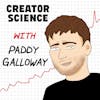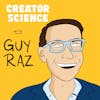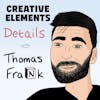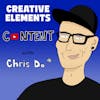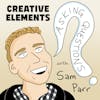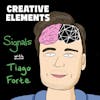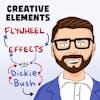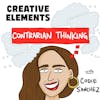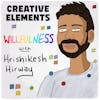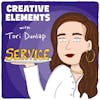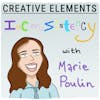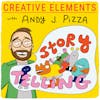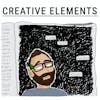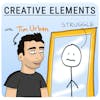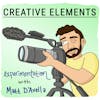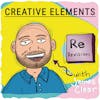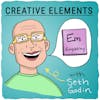
#156: What we’ve learned in our first year on YouTube (feat. our editor, Conor Conaboy)
Play EpisodeThis week, Creator Science celebrates its first anniversary of uploading on YouTube!
This week, the Creator Science YouTube channel turns one year old!
In the first year, we've uploaded:
- 35 interviews
- 2 solo videos
- 9 clips
- 79 shorts
As a result, our channel has:
- 7,600 subscribers
- 255,000 views
- 23,900 hours of watch time
- $1,008.28 in earnings
In this episode, my good friend and YouTube editor, Conor Conaboy, joins me to talk a little bit about our experience on YouTube in the last year.
In this episode, you’ll learn:
- What we learned in our first year on YouTube
- The changes we've made along the way
- How we've improved our packaging
- The challenges for interview podcasts
Full transcript and show notes
Follow Conor on Twitter
Follow Jonathan on Twitter
***
CONNECT
🙏 Make a guest or mailbag request
📝 Check out our curated Playlists
***
SPONSORS
💼 View all sponsors and offers
***
SAY THANKS
💜 Leave a review on Apple Podcasts
Learn more about your ad choices. Visit megaphone.fm/adchoices
Conor Conaboy [00:00:07]:
Hello,
Jay Clouse [00:00:08]:
my friend. Welcome
Jay Clouse [00:00:13]:
to another
Jay Clouse [00:00:16]:
episode of creator Science.
Jay Clouse [00:00:18]:
I'm gonna call this the first episode in a series called the moving files because Mallory and I, right now, are moving homes. And I've been without Wi Fi for a week. It's been a trying trying time. but we are settling in just about ready to get back onto WiFi literally. Don't even have WiFi yet.
Jay Clouse [00:00:42]:
So today, I'm recording kind of a spur of the moment episode
Jay Clouse [00:00:46]:
with my good friend and editor of the YouTube channel, Connor. Connor, say hello. Hello. Connor's rocking his wonderful Freddie Mercury mustache
Jay Clouse [00:00:54]:
once again. That's right.
Jay Clouse [00:00:56]:
In this audio only episode, And we are gonna talk a little bit about our experience on YouTube in the last year because as of this week actually, as of yesterday, The channel is one year old from the first full length interview upload, an episode with Justin Moore followed by an episode with Justin Welsh.
Jay Clouse [00:01:15]:
feel like we've learned a lot in the 1st year, Connor learned a whole lot. A lot. Mostly that I have zero idea what I'm doing. If you're you're the one who pitch me on doing video in the first place. That's true. Let's let's tell the story. So I put out a tweet a year ago, I was close to burning out, and I was like, I need a virtual assistant. Yeah. Does anybody have any idea who I should hire?
Conor Conaboy [00:01:43]:
And then Connor enters the chat. Yeah. It was I saw the tweet. It was, like, 11 PM on a Tuesday. I had nothing going on. Like like like work wise. And I was like, I haven't talked to Jay since pre pandemic. We've done some work together previously. I don't know. I could use some extra money. Might as well see if I can take up some, like, part time assistant work. I messaged you, hey, are you looking for an assistant? Can I be considered? you said no.
Jay Clouse [00:02:10]:
Well, I think you said are you looking for a video assistant or something?
Conor Conaboy [00:02:15]:
Because Well, I I was I was originally find just for the assistant role, nothing video related, and you were like, you don't wanna do the actual assistant part. What about what about video? I was like, yeah. I had a video. why don't we why don't we go ahead and do this? Yeah. And I
Jay Clouse [00:02:30]:
was like, okay. Let's see what you got. And then you came to me with like, a literal Google document -- Yeah. -- than Google document. Just do people say Google document?
Conor Conaboy [00:02:41]:
Google Doc that was, like, several pages long, very thought out about why the podcast creative elements of the time should be a video show -- Yeah. -- which I hadn't really thought about. And that Google Doc almost didn't get presented because you were running busy that day. And you were like, hey, I might have to reschedule. And I was like, I'm gonna put something together. And you're like, can you can you do it right now? is like, yeah yeah yeah. Let's do it right now. I forgot about that. Yeah. So we have them to call right away. I wasn't I wasn't expecting you to be that prepared, to be honest. Yeah. I really wasn't. You showed up with this multi page Google document about why you thought the show should be in video.
Jay Clouse [00:03:13]:
I remember you would I think you had just, like, gotten a haircut. Like, you're a very clean-cut, and I was like, Man, Connor's got his shit together. This is not what I was expecting.
Conor Conaboy [00:03:22]:
Which I didn't.
Jay Clouse [00:03:24]:
It was all for show. But yeah, I went from I went from looking for an assistant to okay. I think I think we should do the the show in video. I mean, I had thought about video previous to that. But you gotta understand if you're listening to this and you aren't yet in the video world, I had gotten at least close enough to realize that this would be a completely different animal. Yeah. Because I didn't what I didn't wanna do was, like, do a low production. Here's the raw footage out of whatever tool you choose to record with, side by side video. I just didn't think that was interesting enough. And even at that point, like, I was really valuing the quality of the work -- Yeah. -- and how things looked and how things felt. And want it to be remarkable. And I just didn't think I could do that personally. I didn't wanna add video editing to my
Jay Clouse [00:04:12]:
skill pile personal
Conor Conaboy [00:04:14]:
Yeah. because I I think one of the first conversations we had was about whether or not, like, you had mentioned, hey, maybe we just upload uncut footage because the audio episode was so produced and so edited
Jay Clouse [00:04:26]:
that you didn't know if you could keep it that same format in video because, obviously, it's much easier to hide cuts in audio than it is in video and make it, like, not look bad. Totally. And I was doing a lot of cuts. I mean, I was spending I was doing the majority of editing on the video app or the audio episodes at that point. I was putting in 5 to 8 hours per episode. Yeah. And see my initial thought was, okay. If I'm going to edit The audio as I'm doing now, how will we possibly then edit the video the same way? I hadn't begun thinking about reengineering the process entirely yet. Yeah. Which we do now. Now we do the initial edit in video. How about you explain kind of the the workflow that we do now? Yeah. the initial workflow
Conor Conaboy [00:05:12]:
starting or what we do now? because That's the truth. Okay. So starting the initial is just kind of get an interview, prep it up, and mostly remove fillers, like ums, awkward spaces, and just kind of redo timing.
Jay Clouse [00:05:28]:
which was pretty easy. What do you mean by prep it up? That might not be something people in this room. Sync like, sync video and audio.
Conor Conaboy [00:05:35]:
and color correct any of the guest footage because I think one of the issues that we run into is not all of our guests have, like, good cameras or good white balance or everything like that. So I try and compensate for that as much as possible because I I don't want like your video looking really good and the other one just looking like absolute shit. I wanna, like, tune it up as much as I can, which isn't always possible because sometimes the video is just video or lighting is just bad. But I'll go through and do all those quality stuff to make it look good, make sure everything synced. And then prior, I would break it out into 3 acts. broken up by the 2 mid rolls in audio. because initially, when we were doing this, we wanted the video production to be nearly the exact same as audio. So we had baked into mid rolls that on the YouTube channel we used to promote the email newsletter and then audio episodes. So if you go back and watch those initial videos on the YouTube channel, there's gonna be 2 self ads.
Jay Clouse [00:06:37]:
which I don't even know if they worked or not. It's it's hard to say attribution is hard, but let's let's dig into a couple things real quick. First of all, you mentioned part of the prepping, you're doing syncing of audio and video. Yep. We use Riverside. I personally love a Riverside. I think among the options, Riverside is great. Yeah. But it's not without some
Conor Conaboy [00:06:59]:
syncing required on our end. Yeah. It's use yeah. It it's pretty system dependent. Like, yours is always, like, three frames off, and guests are, like, 3 to 6. I I I think it depends on the system. I'm not sure of, like, the actual technical details behind it. It's gotten a lot better. Like like, when we had first used it. There were problems with, like, artifacting or lagging and things like that in video that still kind of happened, but much less frequently.
Jay Clouse [00:07:27]:
and much less noticeable. Yeah. So one note for you guys listening is when I start a recording with a guest, I still start with a clap. And same with the voice over recording I do afterwards because that's easier for Connor to sync up. Yeah. Yeah. I would recommend that. I know, like, depending on whatever service you edit on has auto syncs, but it's always gonna be a good idea to sync with the clap just to make sure. So initially, we thought that the video version of the show would be just like the audio version of the show, but with video. And so in the beginning, it was a lot of me trying to impart how I edit the show to Conner. I was like, hey. Listen. Basically, 3 acts as you were saying. We have 2 mid roles in the audio show. So you have the intro of the episode, which is, like, literally the intro that I record. Then we have, like, the the first bit of the interview, which he called act 1. Then we have act 2 between the two mid roles and then act 3 afterwards. And part of that format was taking a little bit of an audio clip from basically all of those acts. Typically, in the intro and episode, which would run somewhere between 3:5 minutes, usually about 4 minutes long in audio. I would have 2 to 3, usually three audio clips from the episode to kinda introduce what's gonna be spoken about and introduce the guests. So in the beginning, it's a lot of me telling Connor how I was doing that in audio. But we quickly found out that that's not exactly what YouTube viewers want or need. Yeah. They don't care. They don't care. They don't care at all. They wanna click play and get into the thing that was promised in the package
Conor Conaboy [00:09:00]:
as quickly as possible. Especially because the the viewer behavior is so much different on YouTube where it's if you're thinking about a new view or a new viewer on YouTuber's a new listener in audio, it's a completely different click. You're it's way more of a commitment and likelihood just to stay. in audio because it's, like, I don't know what the retention on the audio episodes is. It's, like, 90 something super high. It's super high. That's in that's absurd to get on YouTube, which is why it doesn't happen. Yeah. And so, like, we had to change from, oh, people are just gonna watch because Jay's good at interviewing and we're gonna get good information out of this guess. that's a big ask for a new viewer to wait 5 minutes to get to that. So, like, we had to switch that around and reaffirm their click that they made a good decision clicking on our podcast and listening to it right from the get go because we can't have them wait 5 minutes to get to something good. Yeah. And this is something that I just I mean, the bet in doing YouTube at all was,
Jay Clouse [00:09:59]:
well, this will get the show in front of new people. and potentially more people because YouTube is the 2nd biggest search engine on the planet. Yep. It's a it's a place where you get a lot of new viewers if you do a good job. I knew that going in. What I didn't stand about that premise though was by nature of this, you are constantly auditioning to a new person.
Jay Clouse [00:10:19]:
Exactly. They have no patience for your format.
Jay Clouse [00:10:24]:
They don't know who I am. They don't care who I am. they want what was promised in the package, whereas in in audio, there's already a pretty high level of trust When you put an audio episode in someone's feed, they have chosen to subscribe. Your audio is only getting listened to by subscribers, people who already at least know you, probably like you a little bit. There's more patience. It's a different medium entirely. And, situationally, it's such
Conor Conaboy [00:10:50]:
it's way more committed. like, going to a movie versus watching something on Netflix. Like, you're gonna be way more likely to click off on something on Netflix if they don't have a good intro because, like, I spent whatever $15 at the movie theater getting a ticket, getting popcorn, getting a slushy, and I'm sitting here with all these other people. it's such -- Yeah. -- like, to leave that is is a big action, whereas on Netflix, it's just a click. I I don't have to walk up. I didn't spend $15 for this one event, which is what going to a movie is, would be an event versus something more passive like YouTube video or Netflix. And it's like YouTube is even, like, exponentially bigger than Netflix. because even on Netflix, you're kind of like clicking to sit down and watch, whereas YouTube is much more passive
Jay Clouse [00:11:36]:
either second screen or just, like, kinda click and watch. Everything This is just faster. I was actually just thinking that it was the opposite. I was thinking that audio is more passive because it's often a sidecar to something else you're doing. Like, it's very portable elsewhere. I yeah. I I guess passive passive in the sense of,
Conor Conaboy [00:11:54]:
like, driving doing dishes or something like that, is for sure right. I mean, passive as in, like, more conscious of the time you're spending. I guess I could have rephrased that better. But it's like you're way more conscious on spending time watching YouTube video than you would putting on an audio while you're doing something Yeah. because it it feels like you're more committed to that time, so you want the most out of it you can. Whereas, if you're listening to, like, a bad podcast episode while you're doing dishes, doesn't really matter because it's like you're you're already doing something else. I also totally misunderstood
Jay Clouse [00:12:26]:
where views on YouTube come from. I think initially I thought that we were gonna get all our views from search -- Right. -- which is, like, I don't know, what percentage of our views come from search now? Less than 10%. Yeah. Crazy. And that's all coming from, like, probably Justin Welsh. Yeah. Like And Jake Thomas. Yeah. People searching them by name and and there's less content, but they're they're known in those communities. So Yeah. What the game on YouTube is browse and recommended, and that is I mean, to me, you tell me how you feel about this. It feels like when you upload a new video and you press it live, YouTube is very good about giving that video a shot on browse and recommended to some number of potential people. Yeah. And if that goes well, then it expands. It goes to more people. If that initial audition to whatever audience it showed it to does not go well, your video's
Conor Conaboy [00:13:18]:
kinda dead at least for a while. Yeah. For sure. It it definitely works like that. It's it's kinda weird start out because, obviously, the algorithm kinda has a hard time knowing who should watch your videos. And, obviously, that develops as your channel gets more mature. And once it does start develop and get more mature, that initial audience that it's sending out to is always gonna be your core audience. Mhmm. So it's like, no matter what you're making, you have to hit that core because you can make the greatest video, greatest episode in the world. If it doesn't hit that core audience, it's not gonna get shown to anyone else because YouTube thinks it's not good. At least from my understanding, that's why you have to hit that. And and why it's so important to, like, stay on topic and remember your audience and why they're clicking, because if you miss that, then the episode's kind of dead in the water. I think that's what makes getting started so difficult
Jay Clouse [00:14:07]:
because YouTube just doesn't have a lot of data yet. it doesn't know who your core audience is. If you don't make good videos in the beginning and it shows it to its, you know, guess of a core audience, and it doesn't perform with that group because it wasn't right. Yeah. Then all it knows is, okay, not those people, or this video was bad. it takes, like, a video to do well, I feel, for YouTube to get the amount of data that it really wants it needs to say, okay. I think we we have a good sense of who
Conor Conaboy [00:14:37]:
should be the viewer of this channel. For sure. It's definitely like that. And that's why, like, early on, like, when we had talked to, like, Trent Hare, early on talking about blowing up on a video could actually be bad for your channel if that brings in the wrong kind of viewers. Now, like, with interview format, and podcasting is a little bit different because it's that initial, you're you need to have a video pop off to, like, be consistent is much harder because it's less it's less idea focused in terms of how can I make this, like, how can I make an enticing video on browse that some random person is gonna click, it's much harder with an interview format than if, like, say -- Totally. -- Mister b or something when I can just come up with a random idea
Jay Clouse [00:15:22]:
or, like, an insane idea and do it. There's much less action involved. Yeah. I don't know if I would recommend to folks listening to if you're starting a channel from 0, I don't know if podcast long form interviews is the easiest path to take.
Conor Conaboy [00:15:34]:
Yeah. Definitely not. I think there's definitely room to be worked in doing short form interviews, that kind of stuff, and then, like, mixing around. But like, just hour long episodes that try and be everything, it's gonna be you're gonna have a hard time. Yeah. Yeah. If you guys are hearing panting
Jay Clouse [00:15:52]:
or water lapping. Ted and Winnie have now entered the chat, walking around us trying to keep them happy and off our backs. just a quick break for our sponsors and we'll be right back to the show. And now back to the show. Okay. So we kinda cover the original experience, the original edit, the original format of the show. And those episodes were like an hour long. Yeah. Well, I I'll I'll say something on that too. I think the the initial approach that I that I wanted to do
Conor Conaboy [00:16:20]:
was I think a lot of people make a mistake with remote podcasting. and trying to make it too much like in person podcasting. because feeling wise, they're way different. So much different. And a lot of people that do remote try and replicate that same feeling as an in person podcast, and it just doesn't work. Unless your guest has, like, really good mic and camera and you can, like, kinda set that vibe as, like, a dual studio type of thing, then you can kind of do it, like, Remote wise, the editing podcast does it where it's like they'll have their angle set up, so it's not like you're looking directly to a camera and stuff like that. We decided against that mostly because of, like, guest restrictions and the fact, I approach this editing it more like like a Twitch stream than I would a normal podcast. Because at the end of the day, even a remote podcast conversation, it's still just two people talking to a camera, and I wanna lean into that. and make it more digital than try and fight against it and make it try and make it seem like it's something it's not. Tell me more about that. What do you mean by a Twitch stream versus So, like, overlay so, like, when we're cutting the b roll, having their overlay on screen, so it's it's more like a presentation and you're getting talked to than talked at. And it's like you're watching them have a normal conversation live. where they're, like, talking through and working through different things. Sort of the vibe is sort of like the last few episodes, probably starting with the Justin Moore Two. where you guys go through and talk about his coaching business is when I really started to lean into that and make it as digital focused as possible. rather than trying to make it look like a normal interview. Yeah. It's
Jay Clouse [00:18:09]:
it's tough. So there's a couple of, like, subtext here that I wanna dig into. 1, you mentioned the angles and how the editing podcast does as well. I want you guys to picture this and think about this because I don't think most people have thought about this. When you watch an in person interview, a video that was of interview done in person, what you'll probably notice is that the cameras are at what? Like, a forty five degree angle looking usually at one subject, but off to the side, not directly on. Yeah. Usually,
Conor Conaboy [00:18:37]:
On an in person, like interview, you would have 3 to 4 camera angles. 2 of them are gonna be just the individual person you're gonna have one which is a dual view, which is gonna be like a flat spot of the table or wherever they're sitting. And then, like, the higher end podcast is gonna have a 4th floating camera. is gonna look more handheld. It's gonna give you, like, that more of a you're in the room with them type of feel rather than an actual setup. And none of those cameras are looking directly
Jay Clouse [00:19:04]:
flat at the subject. No. And so that that feels just a little bit more, how would you say, like, passive or, like, I'm a viewer. I'm, like, a third party spectator -- Yeah. -- conversation. Right. Whereas in a remote interview, you're typically set up so that you're looking at a camera or a webcam -- Yeah. -- directly on. So it's like that person is at best speaking directly to you at worst staring through your soul. Right. Which is, like, not the ideal viewing experience on YouTube. It's not what people are a cut them to. Yeah. There's a there's an really old video. I don't know if anybody knows the YouTuber Rumi. He made, like, the he he he used to do music impressions where he'd be, like, one guy 43 voices in his, like, first two videos. Like, he doesn't break eye contact with the camera, and you can go through his con his comments. And it's every single comment is about, like, he doesn't break out contacts. Yeah. Yeah. We even just got a comment on the channel recently if someone's saying like, hey, This is a great video, but I found it a little uncomfortable. Jay's looking at the camera all the time. I'm like, alright, hurt. I get it. I get it. But it's hard to solve for because, like, it'd be easy for me to change the camera view or set an angle in in my studio. But the the experience is weird if the guest isn't doing that as well. Totally. And it's really hard to and I I have, like, probably the best opportunity of anybody to to coach the guest on doing angle from a remote recording. But, like, I still feel like it would be difficult for me and the people that I'm bringing on be like, okay. And now, like, let's make sure this is set up at an angle and Yeah. It's weird because you you're adding stuff for them, and it's like, we've had this conversation about getting assets
Conor Conaboy [00:20:39]:
from guests for thumbnails. And it's, like, if it's not perfect, then it doesn't really help us. So it's, like, at that point, do you even say anything or just kinda roll with the punches? Yeah. It's hard. So
Jay Clouse [00:20:49]:
one thing that we try to do let's talk about some of the things we do visually to break up the frame because I think something that you knew from the beginning that we haven't really talked about is the importance of pacing and visual change and novelty.
Conor Conaboy [00:21:04]:
Yeah. With with a lot of remote interviews when COVID happened, people got really accustomed to the normal, like, dual box, quad box, like 0 editing. Just set it up on an overlay. People are talking for an hour. that's typically how podcasting was because it's, like, podcasting came up from comedians who just sit down and talk. And that's, like, how podcasting was, and it's an it's It's an inherently lazy medium done by people who are really talented. And that's, like, why why it works? Why it can't work at all? Exactly. And that's why it worked and, like, everyone tried to replicate that, we're just like, oh, I'm just gonna sit down and talk. Oh, I'm just gonna sit down and interview. It's like that kind of stuff just doesn't work. especially post COVID because it normalized everything being remote. So doing that, I wanted to make it I wanted to start to break it up where it's like, I only have 2 camera angles to work with. How can I make that those two camera angles seem more then 2. And that's, like, using the dual view, which gives us 3. It's not an ideal 3 because it's the same 2 just put together. But visually, for viewer, it is a little bit different. Then we're gonna break up by, like, cutting in and out for Guess' or Jay's, like, how they're speaking and to try and enhance whatever point they're making, whether it's, like, a cut in for a dramatic point to make sure that gets across. cutting out to come back and switching up. And then pacing wise, I try and keep it pretty fast mostly because then when something serious comes, or a guest is really explaining where it's normally I'm cutting between things like, let's say, anytime anywhere from 5 to 30 seconds, than if you have film booth ed going on, you know, a 3 minute talk about metaphors that's gonna hit much harder because I'm just gonna sit on that because he's engaging and stuff like that versus if that was no cuts and stuff like that, the entire tone throughout the episode is the same. And and it's hard to feel and go through a storytelling process with that.
Jay Clouse [00:23:14]:
Yeah. So if you guys haven't watched the channel yet, by the way, if you're listening to this and you literally haven't even seen what we've done on the channel yet, really encourage you to go and watch one of the most recent videos. with Patty or Ed? because -- Yes. Or Jamie. -- we get we get better every week. And those 3 are definitely our best work. And by hour, I mean, Connor, because Connor does all of the editing visuals that that I'm talking about here. So check out Connor's Handywork on the channel. it it's really it's really elevated. Like, I don't think there were many examples for us to look at for remote interview shows that were visually interesting. And I think we've done a pretty good job of trying some stuff out, and we see people taking inspiration from our stuff now. Yeah. all the time. It's very cool, but it's awesome. Yeah. We like it. Okay. So the other change that's really happened is we are getting much more ruthless about cutting down the length of the episodes.
Conor Conaboy [00:24:08]:
Yes. So one of the back to something we said earlier where our initial idea was to keep production as similar to audio as possible, and that kinda kept the vibe of how Jay actually goes about doing the interview and how I edit it, where it was just, like, kinda straightforward. And then as we've grown as a channel, and as we've talked to, like, people like Patty Galloway and done his accelerator, which was insane. we kinda realized we can't do that. We have to get more focused on the prep work, and that's where a lot of our shifting has come starting with Jamie's episode was the first we did this where you and I sit down before a guest comes on, and we'll talk about what's the most important piece of information or most interesting information this guest has that our audience needs. Because once we have a list of that, we can then go back and say, can we package this? So, like, with Jamie's, his big thing was blowing up the Zach and Jay show. There were a super fast growing channel hit, like, 900 k in in 12 months. How did he do it? He did it by stealing quote unquote ideas and repurposing them. I can package that. So it's like we're gonna take that and then that's that idea is going to guide how Jay interviews the guest. It's gonna guide how I edit it. It's gonna guide how I write the intro, and it's gonna guide how I do the concepts for packaging for titles and thumbnails. So versus the old process where I would just kind of get an interview and figure it out, we transferred a lot of that time to the beginning. So we know what the through line of an episode is gonna be before the interview.
Jay Clouse [00:25:50]:
Yeah. Initially, the podcast I think I think this is true a lot of interview shows. It can be very wide ranging. And sometimes people pitch that as, like, the positive for the interview. Like, if you listen to a Tim Ferriss interview, he'll say, enjoy this. wide ranging conversation with guest. In in a YouTube world, especially if you're building from 0, wide ranging isn't really your friend. No. Not at all. You don't know how to package it. Whatever you do choose as a package, and we'll talk about packaging here in a second if this is a new term for folks. Whatever you do choose as a package, People are gonna want that in the video, and once they get it, they're probably gonna click away. So retention will be low. So what we've learned is I don't even think about these as interviews anymore. because initially, it was kind of like a profile of the person. You know, what was your beginning? What was your origin story? What happened then? What happened next? You know, where did you get to now? And now I think about each episode as its own asset of teaching a very specific skill or imparting a very specific idea. Yeah. So that if I wanna talk to you about packaging, I'll say, you should go watch our interview with Patty Galloway. because that episode. In a lot of ways, it's about packaging. Yeah.
Conor Conaboy [00:26:57]:
Yeah. It is and, like, the for that one, ideas too. Like, a lot of any any YouTube person interview, the general thing is gonna be ideas because that's just, like, how it is. But it's, like, specifics of packaging ideas. Ed is, like, making ideas interesting and things like that. And as far as general interviews, it's like, you can do that. It's just hard really hard to grow. Like, you can look at someone like Colin and Samir, who can absolutely do that and get views because they're that authority. But, like, people don't know who you are. People know start that way. Exactly. They yeah. They they didn't start that way. They started very specific. Like, with vlog, they didn't even start with interviews. They started as being like the creator economy guys. and then built that up. I think you really have to earn the right to be wide ranging. Yes. A 100%. Like, you have to You have to get there elsewhere. And, I mean, that that's the goal with this show is, like, even when we have big episodes, like, blow up like patties, I'm aware that every episode we post isn't gonna get twenty times our normal views, which is what that did because it's at, like, 42 k right now. And then and then 3 I I think it was posted a little less than a month ago, Usually, an episode would be a a good episode would be at, like, 2025100. So you're 20 x ing that. Of course, that's not gonna happen every episode. But if we can raise the floor and get more people in there that's gonna be, like, I know whatever episode is posted, I'm gonna learn something even if it's, like, not something I specifically know right now I needed to learn and more people like that to build up the core and just get more people in your overall ecosystem.
Jay Clouse [00:28:33]:
not just the YouTube channel. Yeah. And that's been the whole goal with us. That's that's something that I take very seriously with the creator science business as a whole. You know? I'm I'm in a mastermind with some guys, and I was talking about how much work doing video is. It's a lot. And how how much of a strain it puts on the entire system, and they looked at just our metrics this is, like, months ago. And they're like, oh, you should just stop doing YouTube. maybe she should stop doing podcasting entirely. And I was just like, no. Like, I I hear where you're coming from, but, like, I don't wanna I don't wanna just be another person who learns how to be really good at copywriting and builds a business on a Twitter following because I can copyright. Like, I want to hit all these different platforms, all these different mediums because we're helping people in all these mediums. We need to learn how these things work. And It's a good thing we stuck with it because these last two videos, we were talking before start recording these last two videos on the channel with Patty and Ed. I think the views on them combined is greater than all of the other videos before them -- Will combine. -- most. But, yeah, I think So I think those 2 right now have, like, 50,000, and I think total, excluding shorts, we probably have, like, a 120,000
Conor Conaboy [00:29:48]:
views. So it's, like, at least half if you take out the outliers from that, a 120, like the Justin Walsh, the Hayden and the Jake Thomas,
Jay Clouse [00:29:56]:
then, yeah, it's less than those two videos account for the entire catalog. It's crazy. And the really exciting thing, we won't know if this is true yet because you can't really see a trend without more than 2 data points. Like, you need 3 data points at least to see a trend. But Patty's video was a breakout. Then Ed's video got off to an even better start than Patty's still is.
Conor Conaboy [00:30:19]:
So a lot of that, though, looked like, came from Ed Sharing on his page. Yeah. There's a lot of initial traffic from channel pages. which I don't know. It did Ed share on his YouTube. Is that where it came from? Yeah. So I think I think 1st day that was 25% of traffic. And then what would it be? I think 65% was browse, and then the rest was, like, miscellaneous other things. Hatties was all browse. which is good. They're both good. Like, even channel pay even that channel page growth was really good. Yeah. Like, those browse channel pages is awesome. So my
Jay Clouse [00:30:57]:
theory, and again, we'll find out soon, is that now YouTube has much more data and more accurate data on who is the viewer profile for this channel -- Yeah. -- outside of their immediate subscribers. Yeah. And especially when it comes to, like, YouTube creators,
Conor Conaboy [00:31:14]:
So I think that's the interesting thing before, like, these last couple interviews have been super YouTube focused even though there's a lot of learnings there that non YouTubers take because it's just like it's the same as like, the title principles and all that stuff is the same as copywriting. It's just attention in psychology. But yeah. So so that's that's that's the caveat of this of this audience is, like, now we have a very YouTube more focused audience. So it's, like, in the future, if we wanna package something, even if it's not YouTube related, we're still selling it to YouTubers, so we have to keep that in mind. Just a quick break for our sponsors and we'll be right back to the show.
Jay Clouse [00:31:49]:
And now back to the show. Alright. I wanna continue to keep a pin in the idea of packaging. do and return to that. But I feel I feel like we should keep going down this thread a little bit. A few weeks ago, after Patty's accelerator, when we realized that, okay. We should be putting more time into preproduction. We made the choice to slow down on how often we publish video episodes. and to even focus what episodes become video episodes. Mhmm. Now we have some episodes that are audio only. We have some episodes that are in video. Probably some important context for you guys listening to this is it is important to me to put out a an episode on the podcast feed every week. Now just because it's important for me and what I've promised to you as a listener and the consistency that I want to provide, but contractually, I actually have to do that. as part of being part of the HubSpot Podcast Network, which I love. So that created some friction in the YouTube process because the assumption was if we have to publish an audio episode every week, then we're publishing a video episode every week as well. And a 1 week turnaround time on video was stressful for me, and I think probably 10 x more stressful to you. Yeah. So -- And
Conor Conaboy [00:33:02]:
it it it it was like It was just we kept adding stuff on where it was like the initial role that I had taken on and was doing was so much different at that point where it's like, All of the extra time we're putting into planning prep packaging just took away from everything else, especially the biggest switch was when we started actually doing intros. Like, that was the biggest stuff because, like, between writing and good editing, this these last two have been more simple than some previous ones. But, like, the intro can take, like, 15 to 20% of the entire edit, and it's, what, a minute at most, 2 minutes. So it's like that that just took up a ton of time. So lessening that allows me to, like, spend more time thinking about stuff.
Jay Clouse [00:33:46]:
rather than just having to turn out an episode because we have to post that week. Yeah. Which I love that strategy. I think that was I mean, I know that was your idea, but I forget when that came into the picture when we realized we should do intros, and they should be, like, a trailer for the episode. It was Jake Thomas was the first one.
Conor Conaboy [00:34:03]:
Yeah. because that was that was the first one where and it's it's like I don't know. This is pretty interesting. Like, I look at when you're doing these episodes, you have to be very self aware with, like, what is a good potential episode and what's just a good episode. So, like, with Jake Thomas, being so YouTube title focused. I know that that has a very high ceiling on YouTube because it's so YouTube focused, and that's interesting information. So if I'm gonna switch our process or switch home doing something, that's the episode it's gonna be because I can maximize that potential. which is the same with Patti's. Like, when we did the Jamie's was the first one we did this flip and then double down on it for Patti's episode because that's gonna be such a high ceiling episode. If I'm gonna make a change, it's gonna be here. And then it's and then move it on forward. I remember
Jay Clouse [00:34:50]:
also what kinda preceded that. Patty reached out to me because he was planning the accelerator, and he wanted to do, like, a share of time. That was right after we had talked to Patty. He was like, hey. I want to talk to you about how to use Circle and build community on my accelerator. And if I can give you 30 minutes of my time, we'll do it. So we jumped in, and we're asking questions about retention. And he was basically like, let's look at your analytics,
Conor Conaboy [00:35:12]:
and he saw, okay. Your retention in the first ninety seconds is too high. I would try to keep as many people as popular. Yeah. Sorry. too low. I'll try to keep as many people as possible in that first 90 seconds. Yeah. And that's when we started doing interest. because it was, like, especially the first 30 seconds because, like, especially with any podcast, you're gonna have a big drop off because that's at least from my perspective, from our data, that just happens. Like, no matter how good our intro's been, that's just how it happens. Other shows might other shows and other audiences might be different. But that first 30 seconds, before we talked to Patty, you're we were looking at, like, maybe 63% still around at 30 seconds. We're talking to Patty and I was like, We have to try to get that up to high sixties. Most likely, a good number would be above 70%. And how did we do that? We just started, like, taking basically, everything we're doing is distilled down in the last three episodes of the podcast. And and it it's, like, literally, specifically. And it's just yeah. It's just getting way more focused and flipping the switch and realizing 2 things that, 1, people don't really give a shit about us. Like, that's just how it is. And it's like, you're here for the information that you saw on browse and you're expecting that. You don't they don't care who Jay is. Yeah. A lot of times they don't even care who the guest is. They're more there for the information. And the other flip in my head was realizing people are clicking to learn from our guests, not about our guests. Yes. and and not learning from our guest in terms of their stories, I wanna hear what did they actually do? Yes. Like, I we don't need the host in the intro to be you know, like the guy RaaS style where it's like telling the story through their life that you can take nuggets
Jay Clouse [00:36:57]:
from. I wanna hear exactly what he's doing right now. Yes. Yes. I don't even think about the show as an interview show anymore. Like like, I want everything to feel like a conversation more than an interview -- Yeah. -- because it's it's more I mean, we we've been following our natural curiosity more and more. Like like you just said, like, if you listen to or watch the videos with Jake Thomas, Jamie Ross Thorne, Patty Galloway, and Ed from Film Booth. You'll literally be up to speed on everything we've learned because those conversations are what led to everything we're doing on YouTube. All of those episodes were conversations we had 4 months ago and started doing, and then they their episodes just came out. Yeah. wanna spend a little bit of time before we close out here talking about packaging because I think it's an important concept, not even just for YouTube, but really any platform you're on. You know what's really funny to me is a lot of the stuff people think is, like, new creator stuff. But so much of it comes from decades -- Yeah. -- of -- Old media revenue. -- reality shows. Yeah. Packaging is not a new concept, but it's new to this class of creator -- Yeah. -- who didn't have an SVP or a boss teaching them how things are done here at CVS or NBC or whatever. So let's start with YouTube.
Conor Conaboy [00:38:10]:
How would you find packaging? Title and thumbnail is mostly and I Yeah. Title and thumbnail, and then that kind of extends into the intro
Jay Clouse [00:38:19]:
just because the intro is has to be complementary to that because you have to reaffirm the click. So let me let me try to make a metaphor off the dome. We'll see how this goes. Yeah. It's Christmas morning. You look under the tree, You see all the packages. You can open any one of them that you want. Yeah. Which one are you gonna pick? Right. The one that's most visually interesting to you. Yeah. Where you think you can guess what's on the inside, but you don't totally know. Right. You know? That's what's happening on YouTube. It's on the on the browse screen, on the recommended, People are getting shown, I don't know, a dozen maybe more video options. Yeah. And they're gonna click on one of them -- Right. -- if they click on anything at all. So the content of your video doesn't even matter if people aren't compelled by the package to open it. Right. And then how the intro plays into that is if you open it and you find out your brother
Conor Conaboy [00:39:10]:
tricked you and it's just a big box and ends up being socks. And that's like a bad intro. because you're like, oh, you got me with the click, but then you kinda debated me. I don't want this anymore. I don't like this. And if I saw that the from on that package was my brother, then I'm probably not gonna open another package that is from my brother. Right. This metaphor turned out pretty good. Yeah.
Jay Clouse [00:39:29]:
But that applies to things like email too. You know, think about the subject line of your email as a package, the from the from name on your email as a package, the experience of reading your email. if we didn't enjoy that package, we're not going to open it again. But the the idea here, what makes a compelling package? What makes something that we can click on? Well, it has to be visually interesting, has to be psychologically interesting. Usually, it opens a loop that, like, begs to be closed It's also clear in a way. Yep. Like, I think one of the issues
Conor Conaboy [00:40:02]:
you may disagree with this. We'll find out. think one of the issues with our initial package for Jamie's video -- Yeah. -- was maybe the thumbnail wasn't as clear as we thought it was. Yeah. The initial packaging on that was a complete miss. Like, I I completely missed on that. I think if we I think the two things with that episode is I missed on the packaging. And the first part of the conversation that you guys have isn't as related to the packaging as it should be. So, like, with patties and Ed's episodes, The first the the, like, the the hot start would be diving right into the packaging. So with Ed's it's talking about how to make ideas interesting. That's the first, I don't know, 8 minutes with patties. It's gonna it's him talking about how you're not spending enough time planning. With Jamie is the idea is how to steal a YouTube video and it's about brainstorming and picking apart what made other people's videos successful. But the first question, that I started the edit with was how is the YouTube landscape changed since like you had started? Which is an interesting question in general. but that's not why they clicked. So I I think I think that definitely hurt the performance. And also, just so listeners know, The episodes are out of order from like how it actually the conversation actually happened. So I reorder all of the different topics after categorizing them into a way that makes sense in the story and fits the packaging.
Jay Clouse [00:41:23]:
The actual conversation doesn't happen the way it does in the edit. we have to call that out because if you just watched it or listened to it, you wouldn't know it. Right. Because Conner does a great job of editing, but, like, we also call that out to show you just how much work is going into this. Yeah. And we are not at the top of the game by any means. Like, we're we're learning. We've gotten so much better over the last 12 months. But just wanted to call out. Like, if you're considering YouTube and you're not there yet, consider the the time and work necessary. If you're not excited about video or YouTube as a platform, you're gonna it's gonna be hard for you to
Conor Conaboy [00:42:02]:
play this game. Yeah. You're also gonna have to cut stuff you like because it's like our episodes, usually, the interviews are 45 minutes to an hour a half. And right now, I'm I'm I don't want a video to be like over 35 minutes. So I'm cutting at least half of the episode. Yeah. Which
Jay Clouse [00:42:18]:
sucks because like, but This is useful. This, like, isn't bad. Why should I cut this? But, like, if you look at the results, I'm not gonna say that the length of the episode is why the last two have been so good. But, like, if you look at the trade off you're making, like, would you rather have more people watch, finish, and share the episode?
Conor Conaboy [00:42:38]:
at the expense of cutting some stuff out? Absolutely. Yeah. Like, that's why we do this. Yeah. It's just it's it's to stay as focused as possible, like, you know, on the the Jamie episode, one of the examples is, like, I had a question. We did talk about burnout at the end, which is the caveat to, like, leaving some of your focus is, like, stuff that's relatable or other people talk. So it's like, obviously, if 2 creators are gonna talk about burnout, there's always a good topic. Like, always people always talk about topic or that topic. because people experience it all the time if you're doing that. So of course, I'm gonna leave that in. I'm just gonna slide it to the end. Like, no matter where it happens, I'm gonna push that to the end. because the the chances if you've sat there for 25 minutes, you're probably gonna watch that part because it's interesting. But if you click to learn about brainstorming,
Jay Clouse [00:43:23]:
and that was 10 minutes in. Talking about burnout, you'd be like, I thought this is something different than what I clicked on. we've been getting some comments lately of people saying, like, I wish this was 2 hours long. Yeah. You know, which is You don't. I know. 1, no, you don't. But, 2, That is why it's so powerful to make things short because that is exactly the feeling I want you to have -- Yeah. -- finishing a video is I wish that was longer, not I don't wanna watch the rest of this and click away. Yeah. And I think that's also a testament to not knowing how how much it's edited down of of being like, you don't Like, you wish it was 2 hours, but it's like, I can guarantee you the full hour you wouldn't have stayed for. Yeah. So I I I've been thinking about this. You really you want the experience of watching a video, you wanna lose track of time. Yeah. Like, you don't wanna realize how long you've been watching. Yeah. It's just like I can't stop. And The packaging plays a big role in that like you're saying. If I click on this for the package, I want the payoff or at least the topic to be happening quickly
Conor Conaboy [00:44:24]:
so that I don't even think about the fact that I'm waiting for the thing. Right. Yeah. because it yeah. If if you click if I click on Patty's episode, Like, like like, let's say we packaged the patty episode like like John Yuchai's. We're like Mister Beast's secret YouTube consultant. If we packaged it that way, And then in the the first second, Patty's talking about you're not spending enough time planning, you might think, okay, maybe he's talking about Mister Beast, and then you're gonna go into the episode and you're like, Mister Beese's mentioned, like, offhand once 20 minutes in. You'd be like, I don't I don't quite get it. I clicked on this. And the thing is you wouldn't even make it 20 minutes. you get 5 minutes in, you're like, where's Jimmy? I clicked on this for Mister Beast. I I clicked on this to know the behind the scenes details of this dude who works with my favorite YouTuber. Totally. Why aren't I getting that? And then that's a dissatisfied viewer. It's gonna hurt the video, and it's just the wrong audience. Totally.
Jay Clouse [00:45:15]:
I was initially gonna plan to cut this off around here, but there's actually something else that I talk about that I think people would Yeah. I I have as much time in the world. This is gonna take a few hours. This is what the people want. Yeah. This is fun. I I would I wanna talk about our initial strategy on the channel of doing long form, clips, and shorts. Yeah. And now we're not doing that. Right. But if you talk to a lot of people who do long form interviews on YouTube, they will tell you that you should do clips and shorts. Right. So let's talk about why we backed away from that. I'll let you kinda take the floor on it. Yeah. So when we had started the
Conor Conaboy [00:45:48]:
because of capacity, we were full length episode per week. five shorts in one clip. And a clip in our Yeah. A clip being a longer than one minute landscape view not vertical of the episode. So if you go on our channel like Thomas Frank has won where he talks about why he makes everything free, there's one. I think I think the best performing or the best performing one is Justin Welch's, which is specifically taking about, like, his LinkedIn strategies or like LinkedIn profile, I think. Yeah. It's like, how to make a great LinkedIn profile? for LinkedIn profile. Yeah. And then, like, Kristos would be like,
Jay Clouse [00:46:25]:
how this person did x or whatever. So they're like they're like 2 to -- 8 minutes. -- 8 minutes. Yeah.
Conor Conaboy [00:46:32]:
And those just they didn't really hit And capacity wise and looking through, like, who our viewer was, I didn't think people would would come to click for that. I I think you'd have 2 separate audiences living on the same long form channel, which isn't something you want. because I think it's a completely different type of viewer. And the reason why I we stopped doing shorts was mostly capacity. And because you you have to treat shorts as a completely different audience, and taking my focus away from the long form and putting that onto an audience. A different audience when we didn't even have one in long form just didn't make sense. Yeah. Capacity is the biggest driver for why we're not doing that. It's not -- Yeah. -- it's not an invalid strategy.
Jay Clouse [00:47:14]:
The thing about clips is clips are easy to package. Yeah. But in a interview context, I don't know if it makes for a great post click experience.
Conor Conaboy [00:47:25]:
Especially especially talking like education stuff, because most of the time when you're seeing clips pop off, it's usually, like, It's usually ridiculous stuff. It like, if someone sang something ridiculous, it's it's like a controversial figure. It's something like that. With education clips, it's really hard because like, will open. And normally, what you would do like, let's take film booth, Ed, for example. Like, why why would you watch a clip from our podcast about Ed, like, talking about something specific versus the long form versus just going to Ed's channel and watching a video on the same thing. because Ed's ed's short video is always going to be better than what we can do just taking out a podcast clip. So why is someone gonna come to our channel to click on that?
Jay Clouse [00:48:09]:
It seems like we're getting to a point where now now I'm spitballing. We have enough recorded material that we might be able to make interesting, we'll say, videos out of combining some of the similar topics that have gone across guests. Yeah. Something like We talk to x number of YouTube experts about how to come up with ideas. Yeah. And then do kind of like a tying together of clips from different interviews probably with some transition
Conor Conaboy [00:48:41]:
direct to camera stuff in the middle. For sure. Yeah. And and it's, like, even even when we're approaching that, it wouldn't just be a mash up. It would be, like, narratively done through Vio. So it would be, like, talking about Vio and and formulating a story of, like, this is how we're gonna teach this to the viewers using previous episodes versus just saying this is good stuff from previous episodes. Let's mash it together and make an episode. Like, we we'd still have to do the prep work of making sure the packaging is sellable. making sure we can tell a story throughout it. So it's, like, very clear in the through line. This is why you're gonna click on this video. Yeah. Okay. Well, I touched on a lot of the points I had. And I think that we didn't say that you think people assume that they should know if they're thinking about getting started on YouTube. With YouTube, it's very hard to get into. If you're just looking for, like, an instant payoff. I think the only way you can especially in the I'm talking specifically, like, interview formats I think there's a lot of other things you can do on, like, entertainment wise that are different. But unless you have unless you're one of the people that have massive budgets, to be able to throw money at people who have already done it and, like, poach a team, it's gonna take a while. Like, even even as good as the content we were making a year ago wasn't popping off, even though it was good, like, good content people liked it, but it still took us a year talking to, like, the best people on the planet at YouTube to get to a point where we're like, this is kind of where we want the show to go. Yeah. And
Jay Clouse [00:50:10]:
we're working with me, someone who has, like, a lot of context to the creator space. Conner, who's an incredible video editor, He also leads our packaging and ideation and planning for thumbnails with Jonathan, who is an incredible
Conor Conaboy [00:50:26]:
thumbnail artist. Yeah. thumbnail Grail on Twitter. And Jonathan and I are both just straight up YouTube degenerates. Like like OG know inside and out, like, even
Jay Clouse [00:50:37]:
Even if even when I wasn't working in this, like, all I did was I grew up just all I did was watch YouTube and Twitch. That's like it. It's just what I know. If you look at our channel, you can probably tell when Jonathan started doing our thumbnails. Might be a fun game. Play play the game of what when did Jonathan start doing our thumbnails? And which ones have been redone? And which ones have been redone. So we we are playing with a lot of advantages here, and it's tough for us. It's been a huge investment of time and resources on our part as well. So part of the reason I wanna record this episode was to share with you what's gone well, what's been challenging, what you can expect if you're gonna get into it. this certainly applies mainly to, like, a an extra long form video channel, obviously. If you're -- Yeah. -- if you're if you're getting on here to do, like, 4 to 12 minute videos, it's it's gonna be a different experience for you. Sure. Similar principles as far as, like, whatever. But the the actual execution and specific location is gonna be very different. Yeah. But I'm very glad we're doing it. I think it's gonna pay off. We're gonna continue to invest there for -- Yeah. -- you know, the foreseeable future. And it's really exciting now that the videos are on Spotify. So if you look at our interviews with Jamie, Patty or Ed, on Spotify. You can watch the video there or on YouTube. Either way, I'm a happy guy. Thank you guys for watching. If you've checked out the channel, if you want to hear more from Connor, probably
Conor Conaboy [00:51:59]:
what what are you rocking most these days? Follow me on Twitter. Twitter? Yeah. You're not you haven't fully committed to Blue Sky? No. I haven't committed a blue sky yet. Also yeah. I I don't tweet mostly about, like, education stuff. So if you're looking for for tips, I'm probably not the guy to follow, but I shit post and I'm a reply guy every now and then. If that's your thing, you can follow me. atconorcanaboy
Jay Clouse [00:52:20]:
on on Twitter. Jonathan is thumbnail Grail on Twitter as well. But, yeah, thanks for listening. Let me know if you like this episode. You can tweet at me Ajayklaus on Twitter or send me a message on Instagram, Ajayklaus. I'm also on threads now. Let's see if threads is still a thing in a few days, also at Jay Clouse. And if you enjoyed this, leave a review. Reviews on Apple Podcasts go a long way helps us climb the charts. We're very close. into, like, just consistently being in a top 100 position on Apple Podcasts in the entrepreneurship category. So Keeping us there is awesome would be amazing and reviews the way to do it. Alright. We should have cut for an end card here. Just gonna cut it now. Cut.
Most Popular Episodes
New to the show? Check out some of our most popular episodes.








